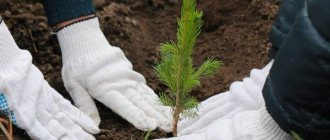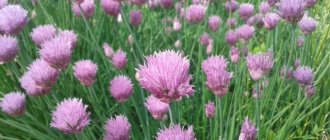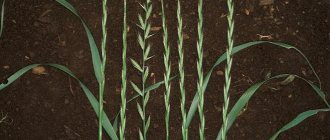Raising animals and poultry on your own backyard has always been a troublesome task. The process can be simplified with the help of new technologies. Fermentation litter will help solve several issues. It is based on fermented milk and photosynthetic bacteria that break down waste. With their use, the chicken coop is always warm, clean, and there is no unpleasant odor. This has a good effect on the productivity of birds, while labor costs are reduced. It will also be useful to know what kind of lighting should be in the chicken coop.
Why are additional bacteria needed?
A challenge for many poultry breeders is heating their premises in winter. Due to the process of decomposition of organic products, the fermentation litter warms up to +50°C. This is a good “warm floor” in a barn!
You can use various bacteria for bedding in the chicken coop
Using it, you can purify the air in a closed room and postpone cleaning up litter for several months. It also provides an additional product - high-quality organic fertilizer.
Effect of use:
- Ammonia is removed. The air becomes much cleaner.
- There is no need to heat the room; the bedding heats it.
- Litter needs to be removed less frequently.
The used litter, which is removed, is used as high-quality fertilizer. It is odorless and ready to use. It can be easily placed close to living quarters. This fertilizer is already ready for sale; no additional preparation is required.
Fermentation litter bacteria do not cause allergies, do not pollute the environment, and are completely safe for poultry and people.
You may also be interested in information about what automatic incubators for chicken eggs exist and how they should be used on the farm.
The video shows a description of chicken litter:
Varieties
There are many options for quality bacterial substrates. Eco-bedding from different manufacturers has different prices. The form of release is also different - granules, powder, liquid solution. The most popular brands:
- BioGerm is a German product. It is produced in the form of beige granules. In addition to enzymes and microorganisms, it contains fragrance. Consumption – 30-40 g of bacteria for bedding in a chicken coop per 1 m². This will be enough for several years. Before use, the chicken bedding is watered with water, and after a while the action is repeated.
- Net Plast is a Chinese product. The composition includes bifidobacteria and synthetic enzymes. It is similar to the previous substance. The difference lies in the temperature, which reaches 25 °C. The use of the Netto Plast product does not require watering. The advantage of the drug is its low price compared to other similar substances. Consumption – 100 g per 1 m². It can be used for 3 years.
- Baikal is a domestic product and therefore has a low price. It was first used as a fertilizer for plants. The advantage of the drug Baikal is its availability. Enzymatic bedding based on it is suitable for laying hens and broiler chickens.
- Bioside is a product of a Russian manufacturer. Operating time – 3 years. It does not require water for mixing, but it will have to be loosened regularly. This bedding for the chicken coop ensures the heating of the flooring to 18-20 °C.
- Bioferm - produced in Ukraine. Mixes with organic matter. Requires digging every 5-6 days. The litter in the chicken coop warms up to 20 °C. The effectiveness of the deep substrate lasts up to 3 years.
Most fermentation bed manufacturers are located in China. Domestic drugs are not inferior to them in quality. If the question arises of which brand to choose, you should focus on your funds and preferences.
How to use
In order for the bacteria to work as efficiently as expected, the manufacturer's recommendations must be strictly followed.
Start bacteria only when the air temperature is above zero, preferably in the warm season. In winter, the temperature on the floor in the chicken coop should not be below zero. If you are going to lay the bedding in winter, then you need to keep it in a warm room for several days, spreading it in a layer of 10-15 cm.
Bacteria will be active only in the layer of natural sawdust. To save sawdust, you can add a little chopped straw or sunflower seed husks.
The permissible amount is up to 30% of the total volume. The normal environment for bacteria to live is wood. Sawdust of medium fraction, 3 cm long, is optimal.
Smaller - they are quickly compressed. Air will not flow into the lower layers. And without air, bacteria do not multiply. Large sawdust will not be sufficiently saturated with droppings, and there will not be the necessary habitat.
You may also be interested in information on how to prepare chicken manure for feeding cucumbers.
The video shows the conditions for proper use:
Probiotics and poultry performance levels
Below are summarized results of studies conducted by foreign and domestic scientists.
Perspectives on probiotic-fed pullets
- increase in egg production of 17-48-week-old birds by 5-6 eggs (3.54-4.25%)
- reducing the age at which pullets reach 50 percent egg production by 6-10 days
- earlier onset of peak productivity – 10-12 days
- increase in the weight of one egg during mass oviposition by 1.1-1.6%
- obtaining longer and wider eggs - by at least 13.3 and 17.9%
Positive trends found in adult birds whose diet contained a probiotic:
- additional production of eggs per laying hen – 2.9 pcs.
- reduction in feed costs per ten eggs by almost 0.04 kg
- increasing the safety of chickens by more than 1.2%
Correct launch of litter
The effectiveness and duration of use of bedding with bacteria largely depends on its correct launch.
Launching litter includes several stages:
- Clean the chicken coop from dirt and droppings, dry it and, if necessary, warm it up.
- Spread sawdust onto the floor in an even layer up to 30 cm thick (keep in mind that this layer will become compacted later).
- You need to scatter the powder evenly over the sawdust.
- The litter must be watered with clean water; it is advisable to use a watering can with a shower. Use only clean, spring water, not chlorinated. Even a small amount of bleach can kill bacteria.
- The moistened sawdust must be thoroughly mixed; it is most convenient to use a shovel for this. Moisture and bacteria should be distributed evenly throughout all sawdust.
- After 5-6 days, check the temperature of the litter. If it is warm, it means the bacteria are actively working.
The chicken coop on private farms is rarely heated. Therefore, if chickens are kept in a separate room, and not in a common barn with a cow or pigs, then its walls need to be insulated around the perimeter so that in cold weather the room has the temperature necessary for the life of bacteria. The litter itself will not heat the room; droppings will not be enough for this.
You may also be interested in information on how to properly place a chicken on eggs.
Popular Products: Chicken Beds
The principle of organizing deep litter is the same: a litter layer of the usual straw, sawdust, moss, sunflower husks is laid on the floor with a thickness of at least 40 cm. Which bacterial preparations to apply depends on the experience of use, the preferred brand, etc.
Bacterial preparations are added to the sawdust material in the form of granules, powder or solution.
BioGerm
The manufacturer of the product is a German company. A complex bacterial preparation that includes components that additionally neutralize the odor of droppings. Destroys both pathogenic bacteria and fungi and mold. The drug is non-toxic, not hazardous to the health of animals and birds, and does not include hormones or antibiotics.
The composition is available in the form of a light brown powder. Packaged in foil bags weighing 1000 g. Deep litter impregnated with BioGerm is used for 2 years.
Material consumption is 50 g per 1 sq. m. Regular packaging is enough for 25 sq. m.
The bedding is prepared as follows: lay the material in a layer of 25 cm, distribute half the dose of the drug and water it with water. Then again lay a layer of 20 cm, pour out the remaining BioGerm and water again. After 2 hours, the substrate is ready for chickens to move in.
You can also use the option with preliminary dissolution. To do this, the powder is diluted in warm water in a ratio of 1:50, wait for 30 minutes until the bacteria are activated. Then lay 25 cm of litter, water with half the solution, distribute the second layer and pour out the rest.
Netto-Plast
Products from Chinese manufacturers, which, however, have earned many positive reviews. The composition of the drug includes lactic acid bacteria, yeast, actinomycetes. They actively prevent the rotting of the bedding material and prevent the release of ammonia, a gas that causes an unpleasant odor in the chicken coop.
Manufacturers insist on using only sawdust as bedding material. Conventional straw absorbs chicken droppings too poorly; it flows down and is out of the range of bacteria.
In fact, farmers believe that well-chopped straw does the job and can be used, but only after processing. A mixture of sawdust and chopped straw shows excellent results.
Net-Plast is available in a variety of packaging - from 0.5 kg to 10. The manufacturer offers preparations for bedding of poultry, cattle, and pigs. You cannot replace one product with another: the concentration of bacteria in different mixtures is different and, if replaced, can lead to an outbreak of diseases. Read about broiler diseases in this article.
Preparing the substrate is very simple: lay a layer of material 40 cm thick, then spread the powder from the packaging over the surface. The substrate is thoroughly watered and gently mixed so that the bacteria are evenly distributed throughout the thickness of the layer.
The main disadvantage of Netto-Plast is that it does not act as quickly as the German product. Only 6-7 days after laying the bacteria come into working mode and the chickens can be placed in the poultry house. Checking the readiness of the substrate is simple: the temperature of the layer should rise to at least +25 C.
BioSide
The domestic manufacturer also offers different options for enzyme bedding on the market. BioSide includes 11 microorganisms that can destroy pathogenic microflora and ensure odorlessness.
The drug is designed for “dry start”. 25-30 cm of sawdust or straw is poured onto the floor of the chicken coop - for chicken the manufacturer recommends this thickness of the substrate, the powder is evenly distributed on the surface and watered with clean water from a watering can. It is recommended to increase the concentration of the drug near the feeders.
Then the material is dug up and the bird is immediately released. During the first 4–5 days, the litter is not touched, but only observed: its temperature should gradually increase until it reaches 20–25 C.
If chickens are periodically kept outside, during the absence of chickens it is necessary to feed the litter with droppings or urea. Otherwise, the bacteria will simply die of starvation.
Consumption rate – 1.5 kg per 10 sq. m. poultry house. The lifespan of the litter is 3 years.
Baikal EM 1
An example of non-trivial use of the product. This product contains bacteria that facilitate the rapid processing of manure into compost, and is used precisely in this capacity.
As practice has shown, Baikal EM-1 gives good results as an impregnation for bedding. Price for 1l. is 430 rubles.
Baikal EM 1 is available in liquid form in packages of different volumes. This form is very convenient, since the bacteria are essentially already activated, and the fermentation process of the litter begins immediately.
Preparation of the litter is very simple: spread a layer of material of any nature, dilute the concentrate - 1 cup of the drug in a bucket of warm water, and pour the resulting solution onto the litter. The birds start immediately. The increase in substrate temperature becomes noticeable after just a few hours.
Read how to make a chicken coop for laying hens with your own hands here.
Tap water should not be used to activate any type of enzyme bedding. It contains chlorine, which will destroy most bacteria and make the drug ineffective.
Fermentation Bed Maintenance
To ensure that bacteria work well and multiply, follow these recommendations:
- Maintain the time for bacteria to start (5-7 days).
- Control the number of birds per square meter of litter . When there are few birds and little litter, the bacteria have nothing to feed on, they starve and may die. When there are a lot of birds, the bacteria do not have time to process a large amount of droppings and also die. In addition, the birds compact the bedding tightly, there is not enough air and this also threatens the death of bacteria.
- They react poorly to high humidity . Keep in mind that they produce a lot of moisture. Ventilation in the chicken coop should be very good.
- In the heat of summer, you need to make sure that the litter does not dry out, and if necessary, additionally water it with clean water.
- In order for the air exchange in the bedding to be good, it must be periodically dug up to the entire thickness of the layer.
- During the summer, provide an area in the chicken coop without fermentation litter. Birds will stay there if the litter with bacteria gets very hot.
It is also worth learning more about which chicken breed is the most egg-laying.
The video shows how to maintain the fermentation bed:
Keep in mind that bacteria are killed by chemicals that are used to kill parasites of birds, insects and rodents.
Animal yard - clean yard
Regular use of live bacteria shows that:
- Straw and manure are turned into compost.
- Biological waste is broken down.
- The unpleasant odor is significantly reduced.
- The number of pathogenic microorganisms is reduced.
- Creates additional warmth during the cold season.
- You can clean the room less often.
We always have the drug in stock. We deliver it to different parts of Russia at low prices. By purchasing live “Barnyard” bacteria from us, you provide strong support for your “feathered farm.” A healthy bird is the key to high-quality and good-smelling meat.
Nuances of use or debunk misconceptions
The advertisement promises that the litter can last up to three years without additional effort. In practice this is difficult to achieve. Already a month after launch, the bacteria work worse than initially. In order for their vital activity to be active, the layer of litter needs to be turned over, loosened and fresh bacteria added once a month. Taking into account the costs of purchasing them, each owner must calculate his own expenses and determine how beneficial the use of such bedding is for him.
It will definitely be beneficial on farms located within the city limits. After all, it is forbidden to store manure on the street there. And the fermentation litter will remove the unpleasant odor from the waste.
Ducks, geese, and broilers do not loosen the litter, but compact it. The top crust needs to be loosened with a pitchfork every two to three days. Avoid over-drying the litter by regularly spraying it with water. If there is little litter and there is not enough of it for bacteria, then manure will have to be added.
Bacteria suffer from cold. To prevent the temperature from dropping too much, cow manure can be added to the manure; it contains more nutritional value for bacteria.
The temperature must not drop to zero, otherwise the bacteria will die! If there is a threat, heat the room. The surface of the litter can be treated with a solution. 2-3 kg of manure is mixed with fresh bran (30 g), two tablespoons of dried bacteria and water. Keep the solution in a warm room for several days, and then pour it evenly over the litter.
On large poultry farms, it is not rational to use litter. After all, the area of the complexes is large, and to dig up sawdust manually it will be necessary to involve many people. And these are extra costs; it is cheaper to remove manure automatically. Again, it is only possible to revive bacteria and monitor their condition using manual labor. At the same time, the birds get scared and experience stress, which has a bad effect on their productivity.
The pungent odor emanating from manure is ammonia, which is a valuable fertilizer for plants. Bacteria will absorb it, and fertilizer from the litter will no longer be as effective as from ordinary humus. The used litter will improve the structure of heavy clay soils, but will not increase the yield.
But how much food for laying hens costs and how to use it correctly is indicated here.
The video shows the nuances of use:
It turns out that fermented litter will justify the labor costs only in small peasant farmsteads. It will really help to heat small chicken coops in winter and eliminate the need to clean them of droppings in winter. But be prepared to take care of it and maintain the viability of the bacteria. You may even have to replace the litter every season.
Perhaps you should also learn more about whether a chicken lays eggs without a rooster and whether this can happen.
What should be understood by the term “probiotic”?
Probiotics are compounds that contain either one beneficial microbe or a complex of microorganisms.
In any case, the microflora of the probiotic, regardless of the method of its application, has a lot of beneficial effects, including improving health and increasing the productivity of laying hens. Probiotics are available in the form of dry bulk mixtures (sold in bags), tablets, capsules and liquid preparations.
In poultry farming, dry formulations containing acidophilus and bifidobacteria are more often used. Such microflora is preliminarily subjected to sorption drying and supplemented with essential amino acids, organic acids, vitamins, minerals and prebiotics.
Reviews
- Lina. Yaroslavl: “I use Bio-Side litter. I launched it two months ago. At first there were some nuances: the room became too humid. We had to install ventilation to allow condensation to escape. I contacted the company for advice on what the thickness of the layer should be and how to launch it correctly. This was all explained to me in detail. Everything is great now. The chicken coop is warm and dry. At least go to the chickens in dress shoes... I’m very pleased.”
- Sergey. Tula region: “ I raised broilers in November-December. Used bacteria. They used a lot of sawdust, they constantly had to add more, a lot of moisture appeared, I thought that the chicken coop would rot. Then I switched to Netto Plast bacteria, they are more expensive, but the effect was obvious. Everything turned out just gorgeous, dry, warm, no stink. I concluded that things were going badly until I started forced ventilation. Everything is fine now.”
Recommendations for using a probiotic
Application options
- inclusion in the feed mixture – 100 g/1 c of feed
- adding to drinking water – 10 g/10 l of water. Important: nipple drinkers are not suitable for this composition, as their nozzles become clogged
It is important to understand that reducing the dosage of a probiotic supplement below the manufacturer's recommended rate will result in an extended return on investment associated with its purchase. And probiotic abuse is a likely cause of deterioration in health and egg productivity.
What should you not combine bacterial litter with?
This type of bedding should not be used on wood floors as bacteria will quickly react chemically with wood surfaces.
If BP is used in the poultry house, then chemical agents against pests and rodents cannot be used in it.
Also, such bedding is not provided if high humidity is constantly maintained in the room, the number of the herd is too large or too small, if there is no traditional bedding on the floor, or if it is too compacted. Also, you should not use enzyme bedding on too dry organic matter, especially during the summer.
How to prepare a poultry house for the release of bacteria
Before you start fermentation bedding, you should prepare the chicken coop properly. Therefore, in the autumn, before the onset of cold weather, the chicken coop should be completely disinfected - all structures, floor and ceiling. All equipment used in the poultry house is also disinfected.
Important! When disinfecting a chicken coop, no chemicals are used that can harm the birds. Therefore, lime is usually used for such work.
After disinfection, the chicken coop should be dried and possibly ventilated.
Then they begin to prepare the bedding. Its lower layer is sawdust. But they can be replaced with high-moor peat. The thickness of such a layer must be at least 0.4 m. The bacterial composition is available in the form of powder, liquid or granules. Any of the purchased forms are evenly distributed on organic bedding.
If the instructions require adding water to the bacterial composition, it is better to do this using a garden watering can. The water should be warm, only in this case the bacteria will quickly activate. You cannot use chlorinated water for this, as chlorine negatively affects the functioning of beneficial bacteria.
It is advisable to use well or river water to activate the bacteriological litter, and the river bottom should be rocky or sandy.
The bacterial litter is moistened, mixed and immediately loosened. If straw is used as part of the main bedding, then it is better to loosen it with a pitchfork. It is easier to dig up sawdust with a shovel or pitchfork.
The liquid version of the litter is started as follows: the drug is mixed with water, then it is evenly poured over the main litter. After 6-8 days you should check whether the litter has started. This can be seen from the increase in litter temperature. After this, you can release the poultry into the chicken coop.











